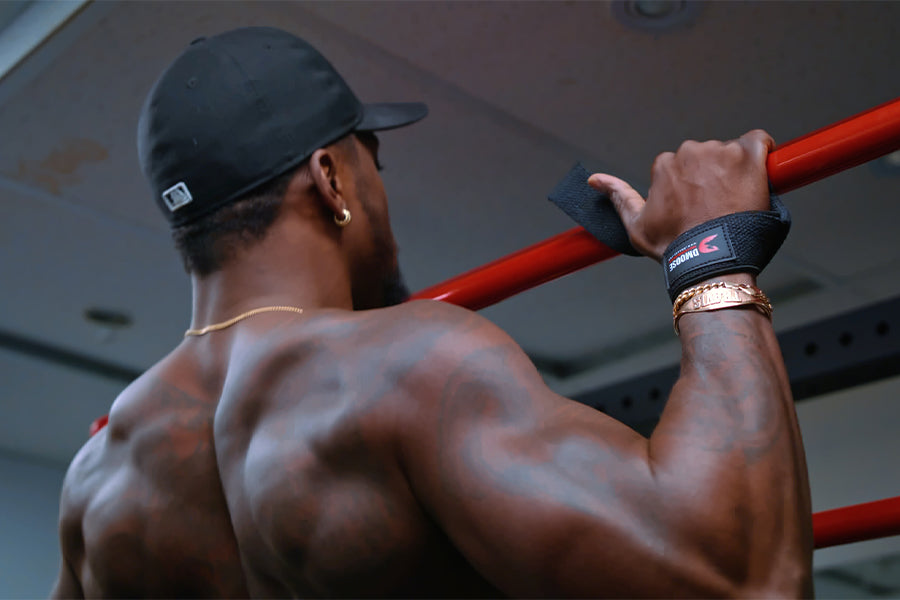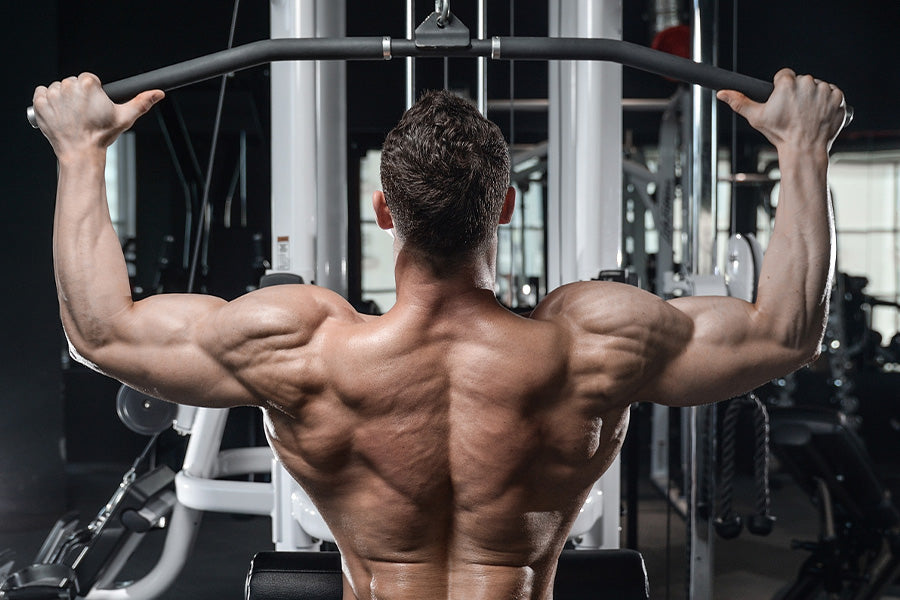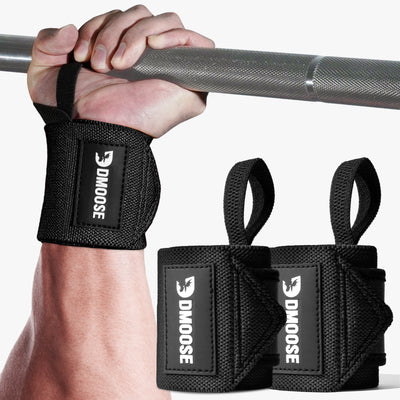Ever find yourself dropping the bar because your grip just can’t keep up? Yeah, we’ve all been there.
That’s where Lifting Straps come in. They’re super simple, but when you know how to use them right, they’ll help you lift heavier and keep your grip from quitting on you.
If you’ve been struggling with grip fatigue or not getting the most out of your lifts, it's time to give straps a try.
Let’s dive into how to use them the right way and start seeing those gains!
What Are Weight Lifting Straps?
Weight lifting straps are adjustable, looped fabric bands that wrap around the wrists and hands, providing added support for your grip. Generally made of durable cotton or nylon material, they come in various sizes to comfortably fit most people's wrists.
These straps can be fastened tightly enough to give extra security while lifting heavy weights and prevent slipping during exercises like deadlifts, shrugs, etc.
How to Use the Lifting Straps?

Using weightlifting straps correctly is key to maximizing your strength training and minimizing injury risks. Follow these simple steps to get the most out of your lifting straps:
Step 1: Put the Strap Around Your Wrist
Start by wrapping the lifting strap around your wrist, making sure the loop is snug enough to stay in place but not too tight to restrict circulation.
Step 2: Pull the Strap Tight
Grab one end of the strap with one hand and pull it tight. Ensure there's no slack, and the strap is securely fastened around your wrist.
Step 3: Grip the Bar
Now, grip the bar firmly with both hands. Get into your lifting position, keeping your back straight, feet shoulder-width apart, arms extended, and head up for stability throughout the lift.
Step 4: Squeeze the Bar to Activate the Straps
Before lifting, make sure to squeeze the bar tightly. This helps activate the straps, ensuring they stay securely fastened and provide that much-needed extra support during your lift.
Step 5: Release the Bar Slowly
Once you’ve finished a rep, release the bar slowly. Keep your arms extended and allow all tension to be removed from the straps. This ensures you avoid strain or injury to your wrists.
Types of Lifting Straps
Lifting straps come in various sizes and styles to accommodate different training needs. The main types of lifting straps are:
- Wrist Wraps: Lifting straps in the form of wrist wraps are short, adjustable straps around the wrists that provide support while lifting heavy weights. They help maintain proper form, reduce stress on wrists, and keep hands stable during some exercises.
- Loop Straps: Lifting straps in the loop style are longer than wrist wraps and feature two loops for each hand to slide fingers through. This type of lifting strap is commonly used for deadlifts and other pulling movements, providing additional grip strength and control when using heavier weights.
- Figure 8 Straps: Figure 8 lifting straps feature an additional loop around both wrists, which helps create an even firmer grip. This type of lifting strap is great for powerlifting, allowing for more stability and control during heavy lifts.
- Quick Release Straps: Quick-release lifting straps are ideal for those looking to quickly add or remove weight without the hassle of adjusting the straps with each set. These straps feature a quick-release mechanism that makes them easy to engage or disengage.
Related Article: Lifting Straps Vs. Hooks – Which One Should I Choose for Heavy Lifts
When Should You Use Lifting Straps?

Lifting straps are a powerful tool to elevate your strength training. They help you lift heavier weights and target muscles more effectively without worrying about grip failure. Here's when you should consider incorporating them into your workout routine:
1. For Heavy Lifts Like Deadlifts, Rows, and Pull-Ups
Lifting straps are a game-changer for compound exercises like deadlifts, rows, and pull-ups. These movements require a strong grip to maintain control, but with lifting straps, your grip will no longer limit the amount of weight you can lift. This helps you focus on the target muscles and ensures proper form, even during your heaviest sets.
2. When Grip Strength Is Holding You Back
If your grip gives out before your muscles, lifting straps provide much-needed support. This is particularly useful during back exercises like rows or deadlifts, where grip fatigue can stop you from performing at your best. Lifting straps help take the strain off your hands, allowing you to push your lifts without worrying about grip limitations.
3. To Focus More on Targeted Muscle Groups
Lifting straps allow you to shift the focus from your grip to the muscles you’re working. For example, in exercises like deadlifts or rows, straps reduce the reliance on forearm strength, letting you fully engage your back muscles. This means you can work your target muscle groups more effectively and efficiently, leading to better overall results.
4. When You're Recovering from Grip-Related Injuries
If you're recovering from a grip-related injury, lifting straps can help reduce strain on the affected area. By supporting your grip, they allow you to continue training with proper form while preventing further injury. Lifting straps can be a great tool for easing back into lifting without overloading the injured area.
Exercises to Perform With Lifting Straps
Using lifting straps during exercises like these gives you the much-needed grip support, so you can focus on the muscle group you're working on, not worrying about your hands failing.
1. Deadlifts

Deadlifts are a heavy, compound movement that challenges your grip strength, and lifting straps are perfect for this exercise. Using straps for deadlifts provides additional grip stability, so you can lift heavier weights without worrying about your hands giving out. They help you maintain proper form and prevent injury by ensuring your grip remains secure as you power through your set. By incorporating lifting straps into deadlifts, you'll be able to push your strength limits and get more out of each lift.
How to Perform Deadlifts with Lifting Straps
- Stand with your feet shoulder-width apart and the barbell over your midfoot.
- Wrap the lifting straps around the barbell, ensuring a firm grip with both hands.
- Engage your core, keep your chest up, and bend your knees slightly as you prepare to lift.
- Drive through your heels and lift the barbell, focusing on engaging your glutes and hamstrings.
- Lower the barbell back to the ground in a controlled manner, ensuring your grip remains secure throughout the movement.
2. Pull-Ups

Pull-ups are an excellent exercise for building upper body strength, but grip fatigue often limits your performance. Lifting straps provide additional support, reducing strain on your wrists and elbows. With a secure grip, you can focus on engaging your back and shoulders, enabling you to perform more reps and work your muscles more effectively without worrying about grip failure.
How to Perform Pull-Ups with Lifting Straps
- Wrap the lifting straps around the pull-up bar, securing them tightly.
- Grip the straps firmly with your hands, keeping your arms extended and shoulders engaged.
- Pull your body upward, using your back and shoulders while keeping your core tight.
- Lower yourself slowly, maintaining control and focusing on muscle engagement.
- Repeat the movement for the desired number of reps, ensuring your grip stays secure throughout the set.
3. Upright Rows

Upright rows are a fantastic exercise for working the shoulders and traps, but gripping the bar securely can become a challenge as the weight increases. Lifting straps help provide better control over the bar, allowing you to focus on proper form and muscle engagement without worrying about your grip. With the added support, you can safely increase the weight and push your training further.
How to Perform Upright Rows with Lifting Straps
- Wrap the lifting straps around the barbell and secure them tightly.
- Grip the straps firmly with both hands, keeping your arms extended and your posture straight.
- Lift the barbell by driving through your elbows, bringing the bar up towards your chest.
- Lower the barbell slowly, maintaining control and focusing on shoulder engagement.
- Repeat the movement for the desired number of reps, ensuring your grip remains secure throughout.
4. Lat Pulldowns

Lat Pulldowns are a key exercise for developing your back and arms, but grip fatigue can often limit the number of reps you can do. Lifting straps help provide the necessary grip support, allowing you to focus on engaging your lats, rather than worrying about your hands slipping or losing control. By using straps, you can perform more reps, push your muscles further, and achieve better results without grip limitations.
How to Perform Lat Pulldowns with Lifting Straps
- Wrap the lifting straps around the lat pulldown bar, securing them tightly.
- Grip the straps firmly with both hands, keeping your back straight and shoulders engaged.
- Pull the bar down towards your chest, focusing on using your back muscles to initiate the movement.
- Slowly release the bar back to the starting position, maintaining control and keeping your core tight.
- Repeat the movement for the desired number of reps, ensuring your grip remains secure throughout each set.
FAQs
1. Do lifting straps go over or under the bar?
Lifting straps should go under the bar to create a secure grip. This allows you to maintain control over the weight and prevents slipping during your lifts.
2. Should you use straps when lifting?
Yes, you should use lifting straps when your grip starts to fail, especially with heavy weights. They provide extra support, allowing you to focus on your target muscles without worrying about grip fatigue.
3. At what weight should you use straps?
Use lifting straps when you’re lifting around 80-90% of your max weight. They help prevent grip fatigue and provide stability during heavy lifts, ensuring you maintain control.
4. How to wear lifting straps?
To wear a lifting strap, loop it around your wrist, then wrap the other end tightly around the bar. Make sure it’s secure to provide you with maximum grip support during your lift.
The Bottom-Line
Alright, here’s the deal! If you want to lift heavier, push harder, and really crush your workouts, lifting straps are where it’s at. They take the stress off your grip and let you focus on hitting those muscles without worrying about your hands giving out.
Whether you're working on deadlifts, pull-ups, or lat pulldowns, straps help you go further and lift more. So, grab a pair and start getting the most out of every rep. Let’s make those gains happen!











